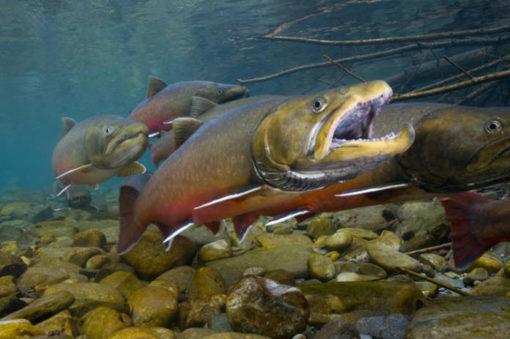
Bull Trout. Image: USFWS.
Bull trout are an iconic Montana native fish that have existed in our rivers, streams, and lakes for more than 10,000 years. But due to habitat destruction, interbreeding with non-native brook trout, and river dewatering for irrigation, bull trout are now listed as ‘Threatened’ under the Endangered Species Act.
Although the U.S. Fish and Wildlife Service and U.S. Bureau of Reclamation have a statutory duty to actively protect and restore endangered species, they have not done so for more than 20 years. Every year bull trout are being killed by the hundreds in the St. Mary drainage due to poor dam design, unscreened diversions into irrigation ditches, and river dewatering. Seeking to force the federal agencies to action and remedy poor river and dam management, the Alliance for the Wild Rockies recently filed a 60-day Notice of Intent to Sue the Trump administration to stop the needless slaughter and take the necessary steps to recover bull trout.
As one agency report from 2011 concluded: “With an estimated annual loss of more than 470 bull trout (age-2 and older) to canal entrainment, our findings indicate that the unscreened St. Mary Diversion represents a significant threat to this important ‘listed’ population and highlights the urgent need for improvements to the Milk River Irrigation Project.” Despite the admitted “urgent need,” in 2015 Bureau of Reclamation staff admitted that they had been “kicking the can down the road” regarding the required Endangered Species Act consultation with the Fish and Wildlife Service and the implementation of protections for bull trout.
The bull trout in the St. Mary drainage on the east side of Glacier National Park have been impacted and killed by the irrigation project in a number of ways:
(1) The St. Mary Diversion Dam, located just downstream from Lower St. Mary Lake is a known barrier to critical upstream migration of spawning bull trout.
(2) Bull trout are diverted into the unscreened St. Mary Canal and most die in irrigation ditches from heat stress and when the canal is dewatered in the fall – when bull trout spawn.
(3) During the non-irrigation period (typically October-March), Swiftcurrent Creek is completely dewatered from the dam to the Boulder Creek confluence to refill the reservoir behind Sherburne Dam, which is a 107-foot dam located just outside Glacier National Park and the reservoir extends into the Park.
This irrigation project has been identified as the primary threat to bull trout in the Saint Mary Recovery Unit and diverts cold, clean, and abundant water coming out of Glacier National Park into shallow, sun-warmed irrigation ditches. But bull trout require the coldest water of any Montana trout, no warmer than 60 degrees. They also require very clean and connected water and are known to travel up to 150 miles to reach the smaller streams in which they spawn.
The design and Bureau of Reclamation management of the Saint Mary Diversion Dam result in the entrainment of up to 600 juvenile bull trout each year into shallow, sun-warmed irrigation ditches from which there is no escape. Yet, there are simple and effective ways to keep bull trout out of irrigation ditches, primarily by installing self-cleaning fish screens at the point of diversion, which are in wide use across the West.
Our rapidly-warming planet and melting glaciers already make it very difficult for bull trout to survive. We are putting the Trump administration on notice that it must take the legally-required steps to stop killing bull trout by needlessly allowing hundreds to die annually in warm water irrigation ditches.